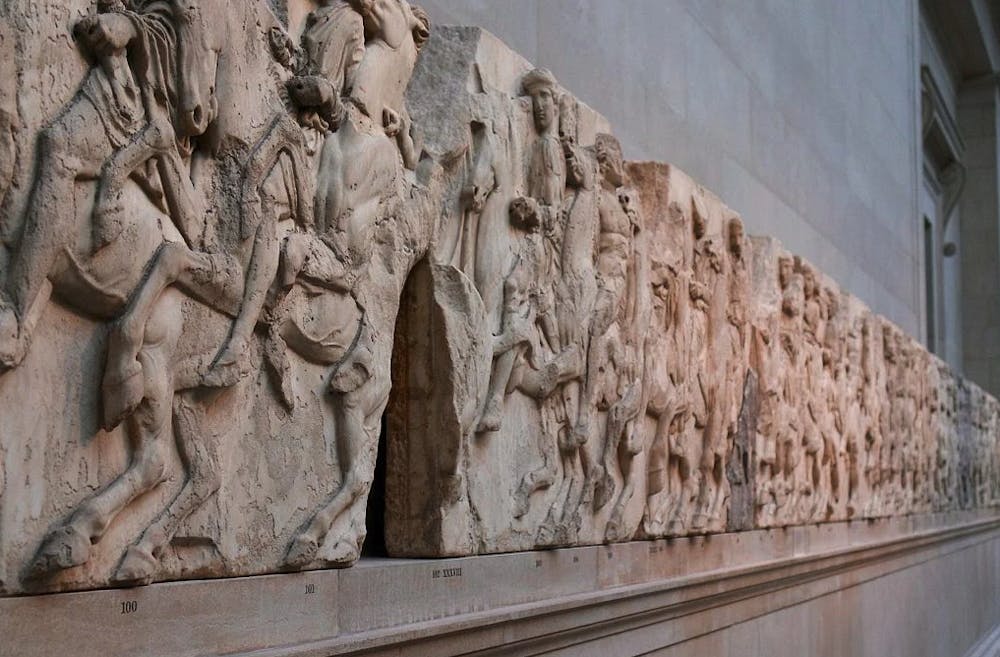In many cases, museums are exhibits of the colonial enterprise. Looted artifacts are ripped from their rightful homes and taken to foreign nations that exotify, catalog and hoard. Recent news coverage of Biblical antiquities returned to Iraq from the Museum of the Bible provide proof of the continued threat of imperialism. What is to be done about the long history of goods stolen from other nations?
A few weeks ago, the Greek Ministry of Culture and Sports announced that the Antonio Salinas Archeological Museum in Italy will be returning a piece of the Parthenon Frieze known as the “Fagan fragment.” The piece is a 12-by-14 inch marble fragment of the foot of the Greek goddess, Artemis. It will be on a four-year loan to Greece, with the intention of it being extended in the future. To replace the piece, Greece offered a 5th-century B.C. headless statue of the goddess Athena and an eighth-century B.C. amphora for the Palermo Museum in Italy. Following the initial four years, it will be switched out for a protogeometric vase.
A similar deal was offered to the U.K. Greek Prime Minister Kyriakos Mitsotakis stated the following: “Our position is very clear. The marbles were stolen in the 19th century; they belong in the Acropolis Museum and we need to discuss this issue in earnest.”
U.K. Prime Minister Boris Johnson refused, claiming that the marbles were obtained legally. He said: “The UK government has a firm, longstanding position on the sculptures, which is that they were legally acquired by Lord Elgin under the appropriate laws of the time and have been legally owned by the British Museum’s trustees since their acquisition.” Johnson later added that it was up to the British Museum, the current holder of the marbles, to determine its rightful resting place.
The Parthenon Marbles were stolen from the ancient Acropolis in 1801 by Lord Elgin, the British ambassador to the Sublime Porte in Istanbul. Fifteen years later, they were sold to the British government and found their new home in the British Museum in the Elgin Room. The sculptures themselves were given a new name: Elgin’s Marbles.
Even in 1816, many protested the marbles’ removal. Romantic poet Lord Byron described the act in “Childe Harold’s Pilgrimage” as “the last poor plunder from a bleeding land.” Regardless, crowds flocked in 1807 to see the arrival of the sculptures to Elgin’s house near Piccadilly.
Today, critics claim that the museum is not well-equipped to protect the famous pieces. In 1802, before leaving Athens, Elgin created casts of the marble. Emily Payne, a fellow at King's College in London, has now used the models to inspect their condition. Through her research, she noticed the deterioration of facial features and vandalism from the Victorian era.
“Elgin’s casts could be important records of the state of the sculptures in the very early 19th century before modern pollution would hasten their deterioration,” Payne wrote in an article to the Guardian.
This damage coupled with water leaks in the Greek gallery in 2018 and 2020 and roof damage in 2021 provided further proof for the Greek culture minister, Lina Medoni, of “Greece’s rightful demand for the sculptures’ permanent return to Athens.”
Similarly, author Geoffrey Robertson QC wrote in his recent work, “Who Owns History?: Elgin’s Loot and the Case for Returning Plundered Treasure,” that the British Museum “would be even greater if it washed its hands of the blood and returned Elgin’s loot.”
2021 marked 200 years since the Greek War of Independence against the Ottoman Empire. The return of the Parthenon signifies not only a piece of Greek history but Greek nationalism and cultural tradition. As Antonis H. Diamataris writes in a National Herald editorial piece, it should be the British, not the Greeks, who must pay for the return of the Parthenon.
Get The Chronicle straight to your inbox
Sign up for our weekly newsletter. Cancel at any time.

